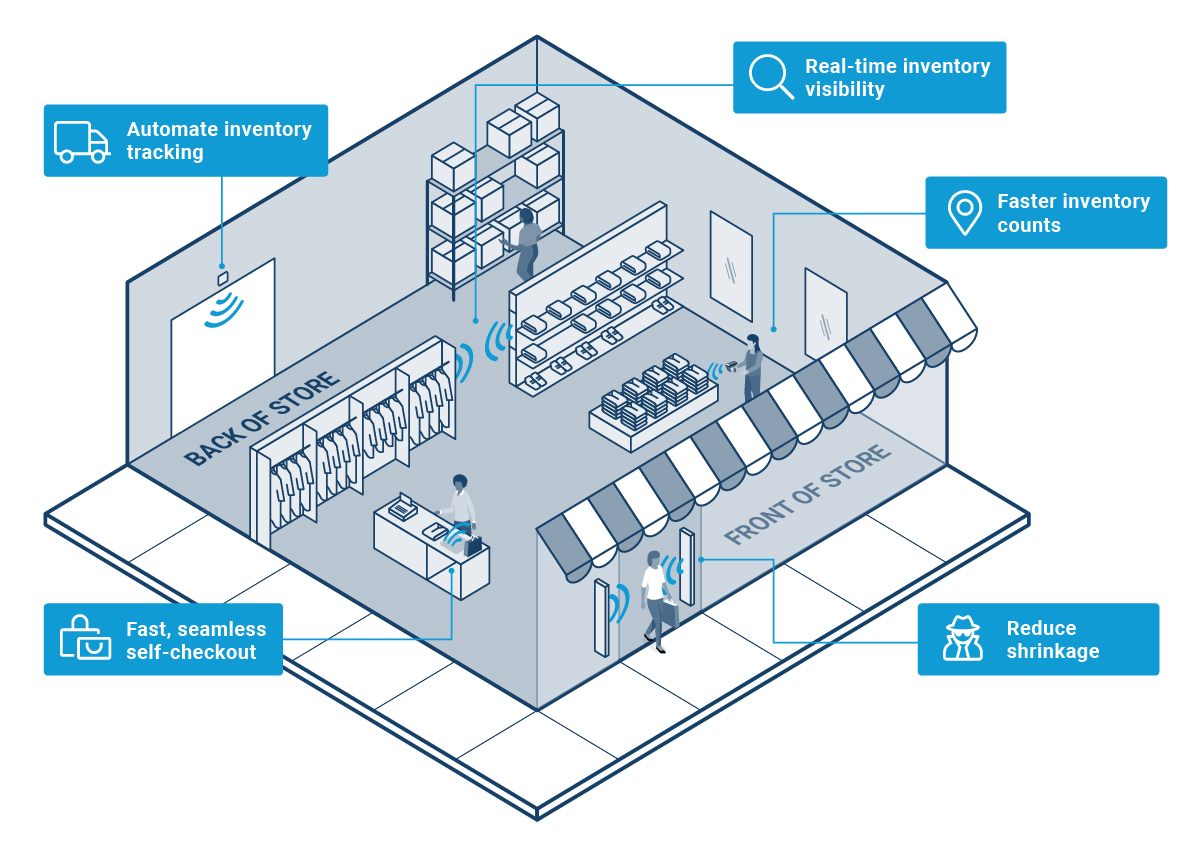Fixed Readers Open a Whole Other World of RAIN RFID in Retail
For RAIN RFID in retail, inventory counts with handheld readers are a great first step. But when retailers add fixed readers to the mix, they gain many more benefits.
Retailers around the world are looking to RAIN RFID as they strive to stay ahead of the curve, and a popular way to begin using it is counting inventory with handheld readers. But there’s a whole other world out there — a world of opportunity using fixed RAIN RFID readers.
There are, of course, many benefits when using just handheld readers for cycle counts. RAIN RFID enables retailers to drastically reduce the time it takes to count inventory, allowing for more frequent counts and letting sales associates focus on what they do best: help customers. And retailers see marked improvements in counting accuracy with RAIN RFID.

Using handheld RAIN RFID readers for inventory counting is a great first step for retailers, yet the power of RAIN RFID extends far beyond. By adding fixed RAIN RFID readers to stores, retailers can automate inventory tracking and gain real-time inventory visibility. They can confidently offer omnichannel fulfillment options to customers. They can reduce shrink and use powerful insights to prevent future loss. They can even use RAIN RFID for fast, seamless self-checkout.
All this can be done with the same RAIN RFID solution using fixed readers, such as the Impinj R700 reader or partner products using Impinj reader chips like the new Impinj E910. Fixed readers can be installed at transition points, such as between the backroom and the sales floor; at entrances and exits to monitor for theft; or at points-of-sale to enable self-checkout. Retailers can even install fixed RAIN RFID readers at warehouses or distribution centers to automatically track inventory as it comes and goes.
With access to more data and minimal risk of human error, companies gain powerful abilities by using fixed RAIN RFID readers.
Unlike handheld readers, fixed readers don’t require a person to manually scan items that are tagged with RAIN RFID tags. Fixed readers can be always on, always scanning for tagged items of interest. This allows retailers to track inventory automatically and in real-time, so they know exactly where and how many products they have at any given moment.
Fixed RAIN RFID readers can read up to 1,000 tags per second and don’t require direct line-of-sight, so they can wirelessly track inventory even if the items pass by in crates or cartons. Items themselves are tagged with RAIN RFID tags, which can be small enough to incorporate into a clothing tag. The tags don’t require their own power source, and instead get energy from radio waves broadcast by a RAIN RFID reader.
Each tag stores identifying information that corresponds to each item in a database, where retailers can store and access information like the location, quantity, size, color, and manufacturing date of each product — among other possible data. A retail outlet, for example, could track which products are most popular, ensure they remain in stock, reduce overstocking of less popular items, and avoid markdowns for excess inventory.
At Macy’s, which committed to tagging every item it sells with RFID, sales volume surged more than 200% after the retailer expanded RFID to its fashion departments. With RAIN RFID, Macy’s can increase merchandise availability and decrease markdowns by selling all available merchandise across their chain, balancing demand with supplies from their network of stores.
Chinese textiles retailer Heilan Home deployed a RAIN RFID solution from Impinj partners Supoin and Xindeco to increase the efficiency of its warehouse operations and lower its labor costs. RAIN RFID saved the company tens of millions of dollars each year and 250 labor hours each month, and inventory intake grew five-fold.
Undiz, an underwear and lingerie retailer in France, saw sales increase by 10% after deploying a RAIN RFID solution from Impinj partner Retail Reload. Stock handling productivity improved by over 55%, check-out productivity grew by 40%, and Undiz achieved stock accuracy of 98.6%,
To learn more about the power of combining fixed and handheld RAIN RFID readers, you can get more information on RAIN RFID in retail and how it enables inventory management, loss prevention, self-checkout, and supply chain automation.
Thursday, August 18, 2022
ABOUT THE AUTHOR

Ashley Burkle
Business Development Director, Retail Industry
Ashley Burkle works with retail partners and service companies to develop solutions that improve sales, efficiency, and shopper experience.
Sign Up for the latest news
